______________________
LIVE - ABOARD
___________________________________
Sail aboard and dive from the Caribbean Explorer II
in the waters surrounding the Caribbean Islands of
St.Kitts & Nevis and Saba with a final departure from Sint Maarten.
______________________________________________
 |
| Stock photo |
____________
ST. KITTS
_______________
SATURDAY April 15
... Boarding ...
_____________
_________________________________________
The FEDERATION of SAINT CHRISTOPHER and NEVIS
Official Status: The World's Smallest Sovereign Federation
 |
| Stock photo |
Known informally as Saint Kitts and Nevis this is an island country and micro-state consisting of the two islands of Saint Kitts and Nevis, both located in the West Indies, in the Leeward Islands chain of the Lesser Antilles. We flew to, sailed from and only dove in the waters near St. Kitts. With 261 square kilometres of territory, and roughly 50,000 inhabitants, it is the smallest sovereign state in the Western Hemisphere, in both area and population, as well as the world's smallest sovereign federation. The country is a Commonwealth realm, with Charles III as King and head of state. It is the only sovereign federation in the Caribbean. (Source: Wikipedia)
_________
SATURDAY
The CREW
Rodney (Captain & DM), Terrance (engineer), Julian (chef), Milan "Thor" (purser, DM, instructor), Briana, Nick & Jonathan (Dive Crew: DM's, instructors). All but Terrance in the crew are divers and all but Julian dove with us at some point.
The DIVERS
An international group - Jeri & Keith, Dani, Trish and Mark from the United States, Bruno from Switzerland & Carine from France; I'm the lone Canadian.
I'm on this excursion with dive buddy Mark Hall Speights. We're representing our FB SCUBA & Snorkel group CANUSUKair.
We were fortunate to only have 8 divers on this trip; the boat can accommodate 18 – because of that Mark & I ended up with separate berths. We arrived a little before the recommended 9 am boarding; the boat was ready for us and our bags were loaded.
 |
Bri (from US) |
 |
Nick (from South Africa, check out his website ... Marine Escapade) |
 |
Terrance (from Sint Maarten, engineer) |
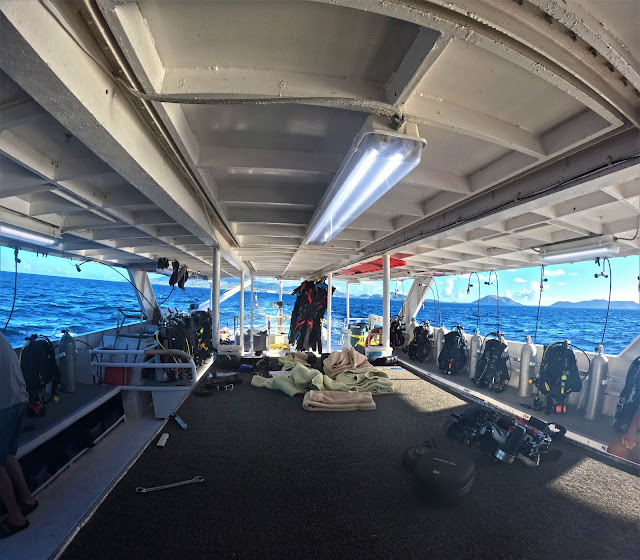 |
dive deck ... better view of the air / nitrox filler hoses above the tanks |
 |
sun deck |
 |
... included only what's needed and all that is. |
_____________________________
SUNDAY April 16 to TUESDAY April 18
... Diving & a Night Crossing to Saba ...
_____________________________
____________
The DIVE SITES
_______
SUNDAY
Dives 1 & 2 were at Monkey Shoals, both slightly under an hour. Not all that interesting a site – used for our check dive.
Skipped today's’ dive 3 to rest my right knee – a bit swollen but ok.
Did dive’s 4 & 5 (night) at the River Taw Wreck. My first nitrox dives today and first time diving 4 tanks in a day.
___________________
The DIVING PROCEDURE
I'm used to a dive boat following the divers (bubble watching), waiting for a surface buoy to be deployed and then meeting the divers at the buoy. I felt it was worth documenting how it's sometimes done from an anchored live-aboard; where the divers swim back to the boat.
In our case, divers enter the water from the port side (an 8’ leap & drop), follow a tag line to the bow and collect as a group at the anchor line, then descend as a group for the dive. Divers then re-enter at the stern after first completing a 3 min safety stop starting at the bow anchor line. About 2 minutes of the s-stop is completed at the bow line first, followed by an underwater swim for the final 1 minute of the s-stop and then a climb at the stern ladders.
What can be challenging for a diver is the safety stop segment - current at the 15' mark for 2 minutes of the s-stop can be quite strong, making holding on securely to the anchor line mandatory in some cases. Divers then leave the line and swim towards the boat at that same depth for another minute to reach weighted drop lines and a rear tag line that floats out from the stern ladders. Once at the tag line divers remove their fins and pull themselves forward to the ladders, hand their fins up to a waiting crew member and climb a ladder - some divers could chose to remove their BCD's at this point; none of our group did. (Note: At the surface, a partially full tank, BCD and all attached gear could weigh as much as 5 - 35 kgs (20 - 80 lbs))
The boat is only anchored at the bow so it tends to swing in both directions, sometimes quickly. That final 1 minute is essentially ... a swim into current chasing a hull that's moving. Divers burn through a lot of air and it an be exhausting.
Bubbles under the surface indicate divers have ascended from the weighted lines and are now following the tag line to the stern.
Divers surface and begin climbing the 2 stern ladders, Nick aids their climb, Thor (left) stands by.
Nick steadies a diver on the rear platform by grabbing the tank valve. From here, divers climb a second ladder to the dive deck.
Surfacing
___________
The WILDLIFE
flying gurnard, puffer-fish, green sea-turtle, caribbean pipe-fish, lion-fish (young), octopus, southern sting ray, lobster, spotted moray eel
 |
Carine Trish |
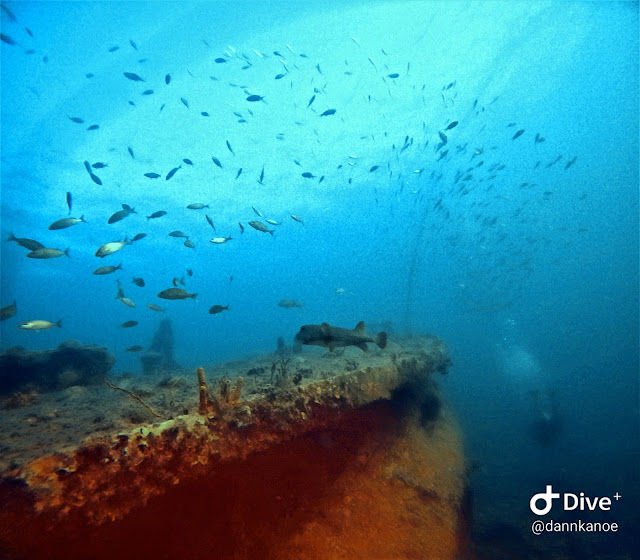 |
large Puffer-fish (centre photo) Green Sea Turtle Bri _______________ The NIGHT DIVERS Keith, Rodney (from Philippines originally, now Montreal Canada), Carine, Bruno Carine & Bruno Keith, Thor, Bri |
 |
Caribbean Pipe-fish & Thor (aka. Milan from Netherlands) Stock photo Caribbean Pipe-fish (zoomed-in) __________________________ |
_______
MONDAY
We moved. Dive 1 at the Corinthian Wreck. This site is repeated for dive 2; I’ll skip it.
Moved again for dives 3-5; to Old Road Bay.
 |
camera station |
 |
electronics charging cabinet: cameras, computers, lights/torches |
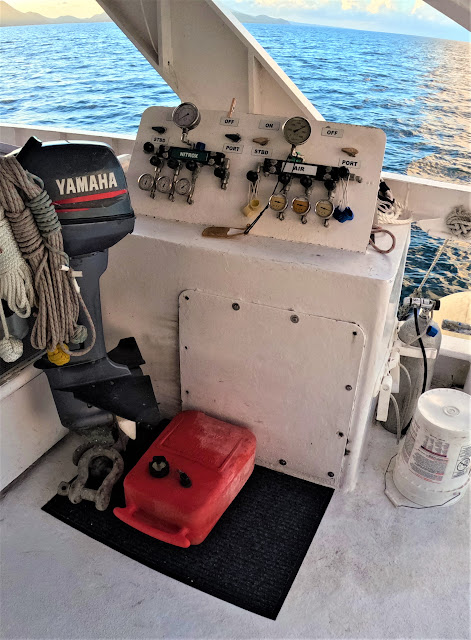 |
nitrox fill console |
_____________
My DIVE OUTFIT
... from the top (mostly) Regulator Setup - OCEANIC Including: FDX IO 1st stage, DELTA 4 primary 2nd stage, AQUATIC PERFORMANCE octopus (emergency/backup reg), VEO 2.0 Dive Computer #1 with an SPG gauge & compass back and inflator/deflator hose Skullcap - NEOSPORT 2.5 mm neoprene Mask🤿 - XS SCUBA GR Fusion 2 w. bifocals & neoprene strap BCD - OCEANIC Ocean Pro Including: A safety whistle, 2 x 1 lb weights in trim pouches (on tank strap), QLR3 integrated side pocket pouches, a surface buoy & reel, zippered pockets (may contain: neoprene gloves, probe stick, mask defogger) Wetsuit - HENDERSON Thermaxx Titanium full 5 mm Dive Computer #2 - SHEARWATER Peregrine on wrist Flashlight🔦 - SCUBAPRO Nova 850R w. safety tether Camera📷 - GOPRO Hero11 Black w. TELESIN handle & safety tether Not shown: MEC neoprene socks/booties, SCUBAPRO JetSport Fins, a selection of: Lycra suits, rash-guards, trunks, headgear Purchased: enriched air nitrox (32% oxygen) tank fills, tank light for night dives Note on Weights: I usually begin a dive trip with 16 - 18 lbs of weight; all gear is bone dry and has often been stored for 6+ months. After several dives (4-6) and once my suit is fully saturated, I typically carry 10 - 12 lbs of weight to descend. With my personalized gear setup, this seems to be where I am most comfortable maintaining neutral buoyancy. |
__________
The WILDLIFE (new this dive)
lionfish, sand diver, web burr-fish, trumpet-fish, spotted drum (adult), black & white seahorse, foureye butterflyfish, yellow sea-horse, fireworm
 |
Sand Diver |
 |
Web Burr-fish |
 |
Trumpet-fish w.Tube Sponges |
 |
Spotted Drum (adult)  Black & White Sea-horse |
_______
TUESDAY
Dives 1 & 2 at Heartbreak & Bikini Bottom.
Then dive 3 after a move to Paradise Reef.
Night crossing to Saba.
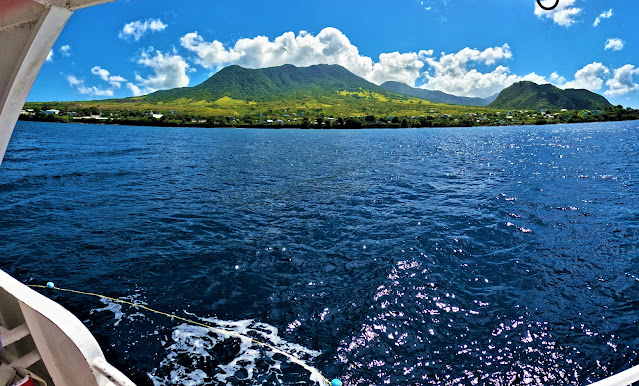 |
St. Kitts |
___________
The WILDLIFE (new this dive)
giraffe garden eels, barrel sponges (large), lobster, toad-fish, bridled burrfish, gray black angel-fish
 |
(l to r) Julian (chef, from Scotland), Dani, Carine, Mark, Bruno Julian only pretended to be grumpy ... I think? |
 |
Overnight sail to Saba (volcanic island, horizon right) |
_______
SABA
_______________
WEDNESDAY, April 19
... A Night Crossing to Saba ...
_________________________
____
SABA
Official Status: Smallest Special Municipality of the KINGDOM of the NETHERLANDS and The Smallest Territory by Permanent Population in the Americas
 |
Stock photo |
 |
Zodiac ride to the SABA marina Photo courtesy MHSpeights |
 |
SABA Marina |
 |
The ' Road that Could Not be Built '; took 20 years and was constructed using local manual labour. |
 |
SABA Airport (photo centre) |
 |
SABA Cemetery |
____________
The DIVE SITES
A number of regulations ensure that the park's thriving aquatic life remains healthy. Zones divide the area according to acceptable uses. Commercial fishing is forbidden in certain places to prevent over-fishing. The reefs are protected from damage by 36 permanently anchored buoys where boats can moor. Scuba divers are not permitted to dive by themselves; they must dive with guides from one of Saba's three dive shops.
Protecting the Saba National Marine Park is not only an environmental consideration, it is also an economic concern. Tourism currently brings in more money to the island than any other industry, and the Saba National Marine Park is the biggest tourist draw.
________________________________
WEDNESDAY, April 19 to FRIDAY April 21
... Diving ...
_____________________________
__________
WEDNESDAY
Dives 1, 2 & 3 were at sites - Custom's House, Tent Wall & Ladder Labrinth. We tried to get to Diamond Rock for our dive 2 at the northern tip, however large white caps caused us to turn back.
We still encountered some quite difficult current at Tent Wall (which was the optional dive 2 site). I probably burned through a few 100-psi fighting the strong current on the return swim to the boat.
We were expecting to ride easy current on our return, but it turned 180 deg in direction during the dive; the strongest I’ve encountered in awhile … good lesson/experience. I now know I can accomplish a swim like that … even with one bum knee. 🙄
 |
Terrance & Jonathan (from St. Kitts) |
 |
Custom's House (note the trail used to carry goods up) |
 |
Diamond Rock (tiny dot at centre horizon) |
___________
The WILDLIFE (new this dive)
squirrel-fish, sea cucumber
 |
Bruno (from Switzerland) w. a small turtle in background Squirrel-fish |
_________
THURSDAY
The boat returned to Diamond Rock for a 2nd attempt. Some of us felt the current might turn as it did previously during the return to the boat and would be quite heavy once again; Trish, Mark and I opted out of that dive attempt.
Turned out this was a great dive; easily one of the better dives of the trip. Current was manageable.
 |
Diamond Rock (above from boat) Diamond Rock (underwater looking up) |
___________ The WILDLIFE (new this dive) black grouper, rock beauty, blue head wrasse, scorpion-fish, honeycomb cow-fish, tarpon, queen trigger-fish |
____________________
SINT MAARTEN
______________
FRIDAY April 21
... Diving & an afternoon crossing to SINT MAARTEN ...
_______________________________________
 |
| Stock photo |
Sint Maarten is a constituent country of the Kingdom of the Netherlands in the Caribbean. With a population of 41,486 as of January 2019 on an area of 41.44 km2 (16.00 sq mi), it encompasses the southern 44% of the divided island of Saint Martin, while the northern 56% of the island constitutes the French overseas collectivity of Saint Martin. Sint Maarten's capital is Philipsburg. Collectively, Sint Maarten and the other Dutch islands in the Caribbean are often called the Dutch Caribbean.
Before 10 October 2010, Sint Maarten was known as the Island Territory of Sint Maarten, and was one of six island territories that constituted the Netherlands Antilles. Sint Maarten has the status of an overseas country and territory (OCT) and is not part of the European Union.
______
FRIDAY
Skipped the 5 am call for a dawn dive.
Did dive 2 at the Saba Tent Reef site; not good, heavy current at the bottom, not fun, murky visibility, surfaced after 34 minutes with 1900 psi in the tank … not a great dive but another good learning experience for me.
A few random photos ...












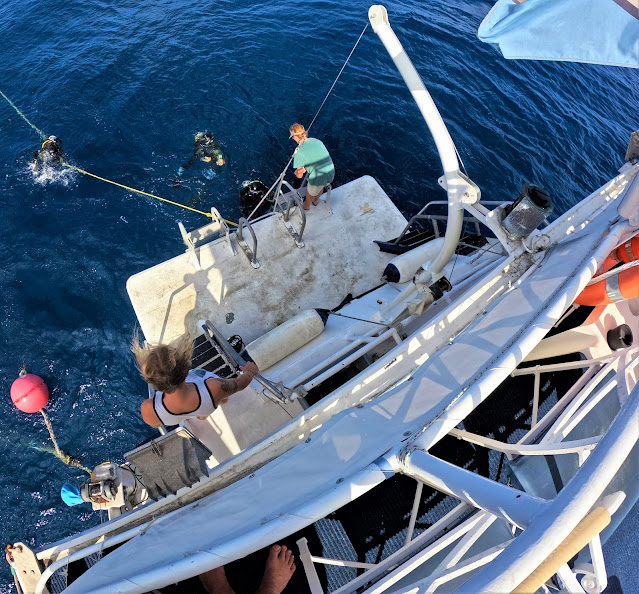





















.jpg)

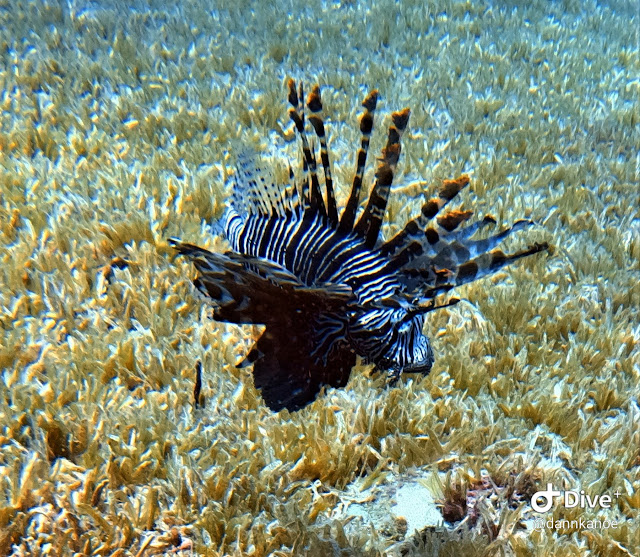










.jpg)











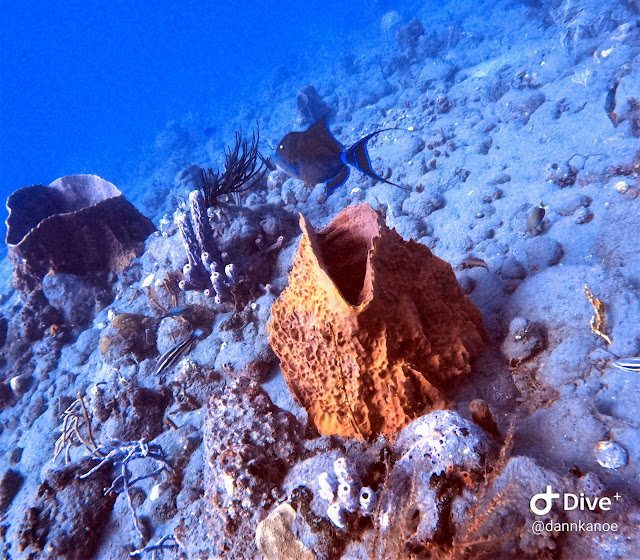







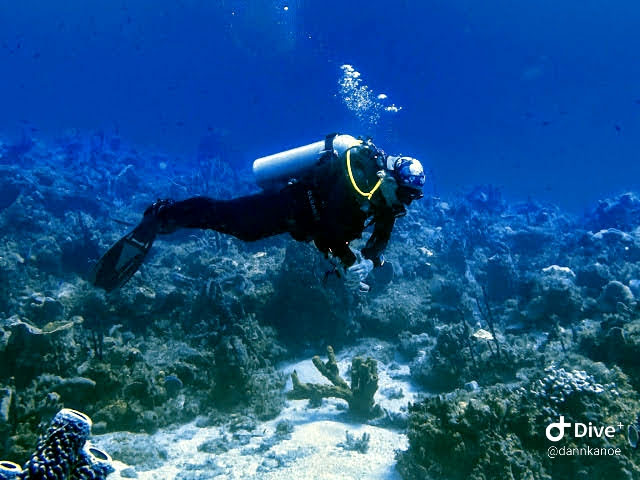

No comments:
Post a Comment
Your comments, suggestions, observations and even opinions are welcome ... please leave some!